Last updated on March 10th, 2022
Our site is reader supported, this means we may earn a small commission from Amazon and other affiliates when you buy through links on our site.
Bamboo provides a wonderful look to any garden whether you are looking to add structure or simply round off a Japanese theme. That being said, you can capitalise upon a variety of shapes, structures and textures when you start growing bamboo in containers.
Container growing gives you limitless opportunities for colours and types, without the worry of bamboo taking over your garden because some varieties are very invasive. Containers also let you move your bamboo around in order to optimise sunlight. Knowing how to grow bamboo in pots is almost the same as growing them in the ground, although it does require a bit more care and the need to choose a good strong pot, ideally, one that is made from metal, and a good mixture of compost and soil conditioner to give them the best start because they prefer moist fertile soil.
Picking Your Container
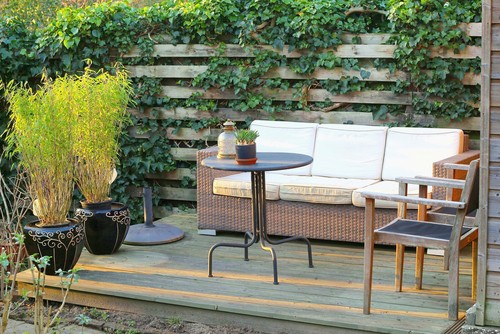
Choose a large strong pot
The first thing you need is a proper container. The container you choose needs to be strong enough to maintain the roots. Bamboo roots are so strong they can break through almost any material, so plastic is usually out of the question, ideally, you want a metal planter or a strong, wooden planter. The way around this is by taking it out of the pot when it’s becoming root-bound and making the root system smaller or dividing the plant and repotting.
Drill holes for extra drainage
Similarly, the container you select needs good drainage. Not all containers come with adequate drainage holes so you should be prepared to add extra holes to the base with a drill if needed. Help give your plants the right amount of drainage too by placing something like crockery (broken pots etc) or gravel at the very bottom of the container to provide a barrier against root rot, plus it stops the drainage holes from getting clogged up.
Consider a wide stable pot for taller bamboo
Depending on the variety of bamboo, the weight and size of it can cause top-heavy containers to fall over. If you are growing a particularly tall variety that is likely to be knocked about by the wind, you want a low, rectangular tub that lacks a narrow neck.
Where to Place Your Containers
Even with a container, location is important. Move your bamboo to a place where it will be protected against the cold winds and a place with adequate sun. Most bamboo plants produce better colour with more sun and some varieties will also do well in shade, so select the right bamboo for the right location.
Read our article on the best bamboo for pots to see some good choices to consider.
Top tip – Test different locations throughout the day before you plant your bamboo so that you don’t have to move a far heavier container after it has been planted because your bamboo isn’t thriving.
Planting Your Bamboo
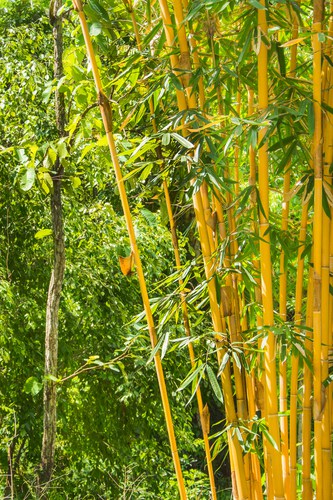
Add crockery or stone to the bottom of the pot
When it comes time to plant your bamboo you want to begin by adding a good layer of crockery or gravel to the bottom of your container. This will not only help improve drainage but can also keep the base of your container heavy enough to prevent your plant from blowing over, so this is your chance to add extra weight.
Use a mixture of 50% potting compost and 50% soil conditioner
Once that is done, fill the container with a mixture of potting compost and soil improver and mix them together, a combination of half and half is usually about right. You can find mixtures that contain slow-release fertilisers or you can add slow-release fertiliser from the very beginning to make sure your bamboo gets all the nutrients they need.
Soak the root ball in a bucket of water for an hour
It is best to place the root ball in a bucket of water for at least an hour before officially planting so that water has an opportunity to seep deeply into the root ball.
When you get your bamboo out of the container from which it came you want to inspect the roots. Bamboo typically has a very dense root system and you will have to break this apart using your fingers and thumbs to sort of tease the roots apart before you plant.
Once you are ready to plant and the root ball is in place, fill in the rest of the root ball with the potting mixture and gently pat it down to eliminate any air pockets. Add an extra 5cm of mulch bark to help with water retention.
Feeding and Watering
Bamboo plants need to be watered regularly when grown in containers, usually at least once a week and they soon tell you when they are dry because the leaves start to curl and turn brown. Ideally, you don’t want to let this happen as the affected leaves don’t usually recover and although it won’t kill them, they won’t look very attractive.
Having a restricted amount of space for the root system means that they will dry out at a faster rate. During the summer months, you should water them every other day, and reduce the amount you water starting in the winter. During the summer you should also apply a general liquid fertiliser once a month, although this is usually not essential.
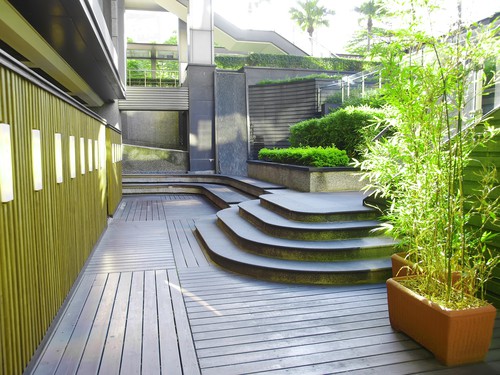
If you have varieties in your garden that are directly growing in the ground, don’t be surprised if the canes produced by your container-grown plants are narrower by comparison. Much like goldfish, the size of the canes is directly related to the size of the root ball so growing bamboo in containers restricts the space allowed for the root ball and therefore the size of the canes.
Overwintering Potted Bamboo
Container-grown bamboo plants enjoy the same level of insulation that the soil provides for ground-based bamboos. That means during the winter it’s much more exposed, so you can protect your bamboo from inclement winter weather by wrapping some bubble wrap around the pots and horticultural fleece, or burlap loosely around the canes.
You can also just bring the plants inside if that’s feasible. Once any threat of serious frost has passed you can remove the protective layer and this is usually around March/April for most parts of the UK.
Repotting Your Bamboo
Eventually, your bamboo might become pot bound and need to be repotted in something more appropriately sized. If you grow bamboo in containers regularly this is something you will have to do every 3 or 5 years during the spring. If you choose to do it in the summer you risk killing the plant. If you notice that your foliage is reduced in terms of density and it’s starting to turn brown it’s indicative of the need for repotting.
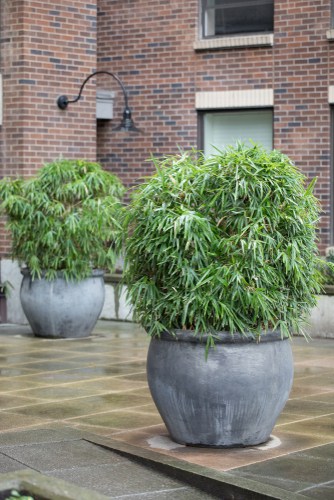
When you re-pot your bamboo, you first need to water it the night before so that it’s easier to lift out of the container and divide. This will also make it easier to transplant without giving the plant a lot of shock, but because of this, it may be a little heavier so you may need 2 people depending on how big your bamboo is.
When you are ready, lift the plant out of the container as carefully as possible so that you don’t damage the root system. Shake any excess soil away and rinse it with water until you can clearly see the root system. Look for a natural point of division and then split your rhizomes into sections of two or three pieces. While you are doing this if you notice any damaged or dead parts (of your root system) you can remove them in the process. Repot in new containers or in the old container with fresh compost and mulch.


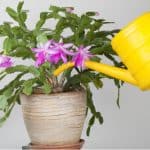
1 Comment
I found this article very helpful for the treatment of Bamboo shoots from pots to soil beds outdoors.